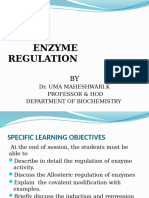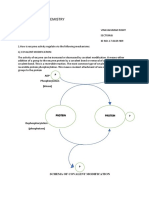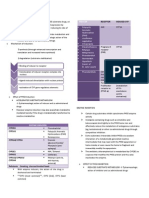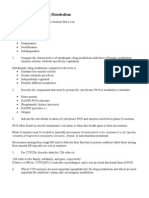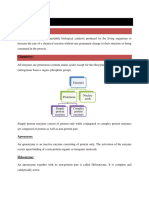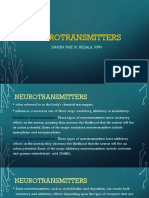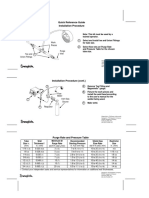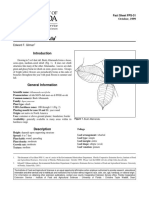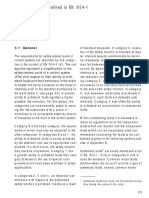0 ratings0% found this document useful (0 votes)
1 viewsEnzymes Inhibition
Enzymes Inhibition
Uploaded by
thanyasri.aktCopyright:
© All Rights Reserved
Available Formats
Download as PPTX, PDF, TXT or read online from Scribd
Enzymes Inhibition
Enzymes Inhibition
Uploaded by
thanyasri.akt0 ratings0% found this document useful (0 votes)
1 views43 pagesCopyright
© © All Rights Reserved
Available Formats
PPTX, PDF, TXT or read online from Scribd
Share this document
Did you find this document useful?
Is this content inappropriate?
Copyright:
© All Rights Reserved
Available Formats
Download as PPTX, PDF, TXT or read online from Scribd
Download as pptx, pdf, or txt
0 ratings0% found this document useful (0 votes)
1 views43 pagesEnzymes Inhibition
Enzymes Inhibition
Uploaded by
thanyasri.aktCopyright:
© All Rights Reserved
Available Formats
Download as PPTX, PDF, TXT or read online from Scribd
Download as pptx, pdf, or txt
You are on page 1of 43
Enzyme Inhibition
Enzyme inhibition is defined as a substance
which binds with the enzyme and brings about a
decrease in catalytic activity.
The inhibitors may be drugs, antibiotics, toxins,
and antimetabolite.
Types of inhibition
Reversible
Irreversible
1. Competitive inhibition – Reversible
2. Non – competitive – Reversible or
irreversible depending on type of
enzyme
3. Uncompetitive – Reversible
4. Suicidal inhibition (Irreversible)
Competitive inhibitor
Inhibitor molecules
are competing with
the normal substrate
molecules for binding
to the active site of
the enzyme
Inhibitor is a
substrate analog
Inhibitor binds to
active site of enzyme.
Malonate inhibits succinate dehydrogenase enzyme
Competitive Inhibition
Typically, I is a substrate analog.
Km is increased in presence of
competitive inhibitor.
The affinity of the enzyme
towards substrate is apparently
decreased in presence of the
inhibitor.
Vmax is not changed
Competitive inhibition is usually
reversible.
Excess substrate abolishes the inhibition.
Clinical significance of
competitive inhibition
Sulphonamides
Antibacterial agent
Bacterial wall is impermeable
PABA
to folic acid.
O
Bacteria synthesize folic acid
from PABA HO C NH2
Sulpha drugs, being structural
analog of PABA, will inhibit Sulfanilamide
the folic acid synthesis in
bacteria, and they die. O
The drug is nontoxic to human H2N S NH2
cells, because human beings O
cannot synthesize folic acid.
Methotrexate
Anticancer agent
It is a structural
analogue of folic
acid,
Competitively
inhibit folate
reductase enzyme
This is essential for
DNA synthesis and
cell division.
Dicoumarol
It is structurally similar to vitamin K
Act as an anticoagulant by competitively inhibiting the
vitamin K activity
Isonicotinic acid hydrazide (INH)
It is a commonly used antituberculous drug.
Structurally similar to pyridoxal
Prolonged use of INH may cause pyridoxal
deficiency and peripheral neuropathy
Allopurinol
Used in the treatment of
gout
Structural analog of
hypoxanthine
Competitive inhibitors
Drug Enzyme inhibited Clinical use
Allopurinol Xanthine oxidase Gout
Dicoumarol Vitamin K-epoxide reductase Anticoagulant
Penicillin Transpeptidase Bacteria
Sulphonamide Pteroid synthetase Bacteria
Trimethoprim Tetrahydro folate reductase Bacteria
Methotrexate Tetrahydro folate reductase Cancer
Pyrimethamine Tetrahydro folate reductase Malaria
6-Mercaptopurine Adenylosuccinate synthetase Cancer
5-fluorouracil Thymidylate synthetase Cancer
Azaserine Polyribosyl amidotransferase Cancer
Cytosine arabinoside DNA polymerase Cancer
Acyclovir DNA polymerase Virus
Neostigmine Acetylcholinesterase Myasthenia gravis
Alpha-methyl dopa Dopa-decarboxylase Myasthenia gravis
lovastatin HMG-CoA reductase Cholesterol
Non competitive – Irreversible inhibition
The inhibitor usually
binds to a different
domain on the
enzyme, other than the
substrate binding site.
There is no
competition between
substrate and inhibitor.
There is no structural
resemblance with the
substrate
The inhibitor combines with the enzymes by forming a
covalent bond and then the reaction becomes
irreversible.
Increasing the substrate concentration will not abolish
non-competitive inhibition.
Vmax is reduced
Km is not changed
Clinical significance
1. Cyanide : Inhibits cytochrome oxidase.
2. Fluoride : Inhibits the enzyme ,enolase, and
consequently glycolysis.
3. Iodoacetate : Inhibit enzymes having-SH
group in their active centers.
4. BAL (British Anti Lewisite; dimercaprol) : is
used as an antidote for heavy metal poisoning.
Difference between competitive & noncompetitive
inhibition
Competitive Noncompetitive
inhibition inhibition
Acting on Active site Other than active site
Structure of Substrate analogue Unrelated molecule
inhibitor
Inhibition Reversible Generally irreversible
Excess substrate Inhibition relieved No effect
Km Increased No change
Vmax No change Decreased
significance Drug action Toxicological
Uncompetitive inhibition
The inhibitor does not have any
affinity for free enzyme.
Inhibitor binds to enzyme–substrate
complex; but not to the free
enzyme.
Both Vmax and Km are decreased
Inhibition of ALP by
phenylalanine. (Regan isoenzyme)
by phenylalanine is an example of
uncompetitive inhibition.
Suicide inhibition
Irreversible inhibition of enzyme activity.
The inhibitor makes use of the enzyme's own
reaction mechanism to inactivate it
Inhibitor is a structural analog
Initially it binds to the enzyme that is to be
inhibited and gets converted to a more effective
product
The new product irreversibly binds to the
enzyme and inhibits further reactions.
Allopurinol Aspirin
A strong inhibitor of Anti-inflammatory drug.
xanthine oxidase gets Prostaglandins are responsible for
oxidized to alloxanthine. inflammatory reactions by the
enzyme Cyclo-oxygenase
In the treatment of GOUT
Aspirin binds to the active center of
. cyclo-oxygenase, and prostaglandin
synthesis is inhibited, and
inflammation subsides
Enzyme regulation
In a metabolic pathway catalyzed by series of
enzymes activity , one enzyme regulates the
over all rate of metabolic sequences as per the
cells demand
Such enzymes are called regulatory enzymes
Types of enzyme regulation
1. Allosteric regulation
2. Feed back regulation
3. Covalent modification
4. Induction and repression
5. Regulation by proteolytic cleavage
Allosteric regulation
Enzymes possess additional sites, known as
allosteric sites
Allosteric enzyme has one catalytic site where
the substrate binds and another separate
allosteric site where the modifier binds
Positive modifier: enhance
the activity of the enzyme
(allosteric activation)
Negative modifier: inhibit
the activity of the enzyme
(allosteric inhibition).
Co-operativity :The
binding of substrate
to one of the subunits
of the enzyme may
enhance substrate
binding by other
subunits.
Pathway Enzyme Activator Inhibitor
Glycolysis PFK 1 AMP ATP & Citrate
TCA cycle Isociterate ADP ATP
dehydrogenase
Glycogenolysis Glycogen Phosphorylase AMP ATP
Gluconeogenesis Fruc 1,6 Bisphosphatase ATP & Citrate AMP
Fatty acid Acetyl CoA Carboxylase Citrate
synthesis
Feed back inhibition
The activity of the
enzyme is inhibited
by the final product
of the biosynthetic
pathway.
Covalent modification
Either addition of a group to the enzyme
protein by a covalent bond; or removal of a
group by cleaving a covalent bond.
Most frequently addition of phosphate group –
phosphorylation
Removal of phosphate group –
dephosphorylation
Glycogen phosphorylase is a muscle enzyme
that breaks down glycogen to provide energy.
This enzyme exists in two interconvertible
forms.
Phosphorylase b (dephospho enzyme) is
inactive which is converted b y
phosphorylation of serine residues to active
form phosphorylase a.
Proteolytic cleavage
Some enzymes are synthesized as Proenzymes or zymogens
which undergo irreversible covalent activation by the
breakdown of one or more peptide bonds.
Proenzymes namely chymotrypsinogen pepsinogen and
plasminogen, are respectively- converted to the active
enzymes chymotrypsin, pepsin and plasmin
Induction & repression
Induction is effected through the process of
derepression.
The inducer will relieve the repression on the
operator site and will remove the block on the
biosynthesis of the enzyme molecules.
Tryptophan pyrolase and transaminases are
induced by glucocorticoid.
Glucokinase is induced by insulin.
ALA synthase is induced by barbiturates.
Repressor
Both inhibition and repression reduce the
enzyme velocity, but the mechanisms are
different.
In the case of inhibition, the inhibitor acts on
the enzyme directly and the inhibitory activity
is noticed and the number of enzyme molecules
is not changed by the inhibitor.
Repressor acts at the gene level; and the
number of enzyme molecules is reduced in the
presence of repressor molecule.
The key enzyme of heme synthesis, ALA synthase is
autoregulated by the heme by means of repression.
The structural gene is transcribed and later translated to produce
the enzyme molecules. The transcription process starts at the
operator site when it is free. When heme is not available, this
operator site is open, and therefore the enzyme is being
synthesized.
When heme is produced in plenty, heme acts as the co-repressor
and in combination with an apo-repressor, heme will shut off the
operator site. Now further production of ALA synthase is stopped.
Compartmentalization
Certain enzymes of the pathway may be
located in mitochondria whereas certain other
enzymes of the same pathway are cytoplasmic.
Example :
Heme synthesis
Urea cycle
Gluconeogenesis
You might also like
- Breaking Hailey 1Document324 pagesBreaking Hailey 1g5bwpqtdkqNo ratings yet
- Enzyme InhibitionDocument8 pagesEnzyme InhibitionfayeNo ratings yet
- Technical Specifications Technical Documents Emerson HD4830Document4 pagesTechnical Specifications Technical Documents Emerson HD4830TERASAT SA50% (2)
- Lecture 4Document6 pagesLecture 4ahmedallord1449No ratings yet
- PharmacodynamicsDocument18 pagesPharmacodynamicsApurba Sarker ApuNo ratings yet
- Enzyme Inhibition Q SolveDocument9 pagesEnzyme Inhibition Q SolveRehman RaselNo ratings yet
- Enzyme Inhibition/Enzyme InhibitorsDocument5 pagesEnzyme Inhibition/Enzyme InhibitorsFaria bukhariNo ratings yet
- ENZYMOLOGYDocument35 pagesENZYMOLOGYmolexasaNo ratings yet
- Enzyme InhibitionDocument3 pagesEnzyme InhibitiongeffkryptonNo ratings yet
- Enzyme InhibitionDocument3 pagesEnzyme InhibitiongeffkryptonNo ratings yet
- Biochemestry 3 AssignmentDocument3 pagesBiochemestry 3 Assignmentkeithotieno5No ratings yet
- (Inhibition and Regulation) :: EnzymesDocument35 pages(Inhibition and Regulation) :: EnzymesAbk MuhdNo ratings yet
- 44 Enzyme InhibitionDocument13 pages44 Enzyme InhibitionMafe HernandezNo ratings yet
- BI 2.3 Enzyme regulation (1)Document33 pagesBI 2.3 Enzyme regulation (1)suriyashankaran042007No ratings yet
- Topic 8 MetabolismDocument23 pagesTopic 8 MetabolismSammy MicahNo ratings yet
- Suicidal Inhibition or Reaction Based Inhibition PDFDocument7 pagesSuicidal Inhibition or Reaction Based Inhibition PDFMuhammad JameelNo ratings yet
- 041220190enzymology - An Overview-3Document17 pages041220190enzymology - An Overview-3slmen1269No ratings yet
- Enzymology: Discuss About Regulation of Enzyme ActivityDocument4 pagesEnzymology: Discuss About Regulation of Enzyme ActivityNorrifhan Akmal IsmailNo ratings yet
- Enzymes 2 partDocument23 pagesEnzymes 2 partkjbutt471No ratings yet
- 303 Control of Enzyme ActivityDocument22 pages303 Control of Enzyme Activitymaryseun2002No ratings yet
- Enzyme InhibitionDocument11 pagesEnzyme Inhibitionshekinah656No ratings yet
- Biochemistry: ADP ADP Phosphorylation (Kinase) PDocument7 pagesBiochemistry: ADP ADP Phosphorylation (Kinase) PVivek VinayakumarNo ratings yet
- Enzyme(Inhibition Cofactors and Coenzymes)Document52 pagesEnzyme(Inhibition Cofactors and Coenzymes)arka paramanikNo ratings yet
- Enzymology 8 Feb 2024 - 5Document42 pagesEnzymology 8 Feb 2024 - 5panchalveer37No ratings yet
- Clinical Application of EnzymesDocument6 pagesClinical Application of EnzymesTemesgen MucheyeNo ratings yet
- Drug Resistance and Drug Synergism - Chapter 7Document40 pagesDrug Resistance and Drug Synergism - Chapter 7Shaun李好No ratings yet
- Enzyme ActivityDocument5 pagesEnzyme Activityjohn_flanaganNo ratings yet
- En ZymologyDocument16 pagesEn ZymologyKhushi MorankarNo ratings yet
- Activity 6 - EnzymeDocument8 pagesActivity 6 - Enzymehmmd.legaspi.jNo ratings yet
- Anti-Neoplastic Agents 1Document76 pagesAnti-Neoplastic Agents 1Soubia AamirNo ratings yet
- Types of Enzyme Inhibitors Modified Ocober 2022Document45 pagesTypes of Enzyme Inhibitors Modified Ocober 2022DENNIS murageNo ratings yet
- Enzyme Inducers and Inhibitors TransDocument6 pagesEnzyme Inducers and Inhibitors TransLeonallee MayorNo ratings yet
- Enzyme Inhibition and Inactivation - Chapter 5Document44 pagesEnzyme Inhibition and Inactivation - Chapter 5Shaun李好No ratings yet
- 2.1 EnzymeDocument13 pages2.1 Enzymesendysim62No ratings yet
- 14 Biochemistry Lecture - Enzymes 3Document60 pages14 Biochemistry Lecture - Enzymes 3AMIRA HELAYELNo ratings yet
- Cytochrome p450 InteractionDocument9 pagesCytochrome p450 Interactionkondaveeti sreenivasulu NaiduNo ratings yet
- 3study Questions-Drug MetabolismDocument5 pages3study Questions-Drug Metabolismapi-3723612No ratings yet
- Enzymes CompletaDocument31 pagesEnzymes CompletaLUCAS OYANEDERNo ratings yet
- Biochemistry 1 Lesson 22 (Enzyme Inhibitors)Document43 pagesBiochemistry 1 Lesson 22 (Enzyme Inhibitors)ansuben961No ratings yet
- 11- Enzyme Inhibition and Related Mechanisms (1)Document30 pages11- Enzyme Inhibition and Related Mechanisms (1)AmalNo ratings yet
- Enzyme InhibitorDocument1 pageEnzyme InhibitorANo ratings yet
- Environmental Fate: AzathioprineDocument5 pagesEnvironmental Fate: AzathioprineasmanNo ratings yet
- Enzyme InhibitionDocument49 pagesEnzyme InhibitionJaden StanislausNo ratings yet
- 2 Pharmacokinetics MetabolismDocument2 pages2 Pharmacokinetics MetabolismLloyd Selorio ArboledaNo ratings yet
- Anti Cancer DrugsDocument5 pagesAnti Cancer DrugsLajja DesaiNo ratings yet
- Enzymes: Keshav Vashistha (Associate Professor, M.G.C.P.S., Jaipur)Document7 pagesEnzymes: Keshav Vashistha (Associate Professor, M.G.C.P.S., Jaipur)KeshavVashisthaNo ratings yet
- 2.PERSETUJUAN DLLDocument6 pages2.PERSETUJUAN DLLPervy FujoNo ratings yet
- CHAPTER 4 Regulatory and Catalysis StrategiesDocument25 pagesCHAPTER 4 Regulatory and Catalysis StrategiesSwad Abdul khalikNo ratings yet
- Enzyme Cofactors and InhibitorsDocument4 pagesEnzyme Cofactors and Inhibitorslayet39267No ratings yet
- Nursing PcolDocument29 pagesNursing PcolRazell Jean ArazaNo ratings yet
- 15-16, Enzyme Inhibition and DeactivationDocument59 pages15-16, Enzyme Inhibition and DeactivationS. AnsaryNo ratings yet
- Metabolism BhramankarDocument48 pagesMetabolism Bhramankarnavneetkumar00709No ratings yet
- 8.1 Metabolism (HL)Document15 pages8.1 Metabolism (HL)riorivfunNo ratings yet
- EnzymeDocument6 pagesEnzymeShaheenNo ratings yet
- Enzyme CompleteDocument34 pagesEnzyme Completehappy9874648No ratings yet
- Regulation of Enzyme ActivityDocument26 pagesRegulation of Enzyme ActivityWeird WorldNo ratings yet
- Pharmacodynamics PDFDocument13 pagesPharmacodynamics PDFUrvashiNo ratings yet
- 2010 FDA Approved DrugsDocument4 pages2010 FDA Approved DrugsShruthi ReddyNo ratings yet
- EnzymesDocument5 pagesEnzymesmusawiralidaudpota8No ratings yet
- Lec 06 Enzyme Regulation PDFDocument6 pagesLec 06 Enzyme Regulation PDFChristopher PhilipsNo ratings yet
- Enzyme Inhibition: Mechanisms and ScopeDocument35 pagesEnzyme Inhibition: Mechanisms and ScopeJason SteelNo ratings yet
- Neurotransmitters: Shaira Mae M. Regala, RPMDocument26 pagesNeurotransmitters: Shaira Mae M. Regala, RPMHERALD LISINGNo ratings yet
- EC4068D-Analog MOS Integrated Circuits Dhanaraj K. J. Associate Professor ECED, NIT CalicutDocument12 pagesEC4068D-Analog MOS Integrated Circuits Dhanaraj K. J. Associate Professor ECED, NIT CalicutM KIRITI SAI KUMARNo ratings yet
- (FREE PDF Sample) Certified Rehabilitation Counselor Examination Preparation 3rd Edition Fong Chan EbooksDocument49 pages(FREE PDF Sample) Certified Rehabilitation Counselor Examination Preparation 3rd Edition Fong Chan Ebookstugrizphukan100% (4)
- Info FishDocument84 pagesInfo FishpeethusreeNo ratings yet
- A Reason For Our HopeDocument9 pagesA Reason For Our Hoperaymond linatocNo ratings yet
- Argumentation ISA-71.04 Vs EN60721-3-3 enDocument1 pageArgumentation ISA-71.04 Vs EN60721-3-3 enCaptain25No ratings yet
- Oec Material Submittal StatusDocument2 pagesOec Material Submittal Statussaqib_dar16620No ratings yet
- Article On History of SeismologyDocument9 pagesArticle On History of SeismologyAsad SohailNo ratings yet
- API Flanges Brochure PDFDocument10 pagesAPI Flanges Brochure PDFguru4lifegmailcomNo ratings yet
- Chatper 3 Geometry PDFDocument49 pagesChatper 3 Geometry PDFCuong LuuNo ratings yet
- Bestway MKR5000D Series OwManual (EN)Document9 pagesBestway MKR5000D Series OwManual (EN)VicNo ratings yet
- CAN Article in Mikrobasic PRO For PICDocument2 pagesCAN Article in Mikrobasic PRO For PICJoseph ThomasNo ratings yet
- BS 1881-Part 115-86Document11 pagesBS 1881-Part 115-86jaafar abdullahNo ratings yet
- KoftaDocument11 pagesKoftaPitractor-gamingNo ratings yet
- Tourism in India by StateDocument84 pagesTourism in India by Stateabhay_patil_22No ratings yet
- CoalDocument36 pagesCoalYusup Maulana SpNo ratings yet
- Speech Minahil Raza EnglishDocument1 pageSpeech Minahil Raza EnglishMiriam Alonso MercaderNo ratings yet
- Swagelok Magnehelic Gauge InstructionsDocument4 pagesSwagelok Magnehelic Gauge InstructionsAnonymous vF4wgBTdSbNo ratings yet
- Basic Ee Module 1 Discussion 2 Me2bDocument41 pagesBasic Ee Module 1 Discussion 2 Me2bStephen papa100% (1)
- Manual de instuciones HauckDocument35 pagesManual de instuciones Hauckluiz brenzinkNo ratings yet
- Nursing Care Plans:Guidelines For Individualizing Client Care Across The Lifespan, 7 Edition DoengesDocument5 pagesNursing Care Plans:Guidelines For Individualizing Client Care Across The Lifespan, 7 Edition DoengesNica PinedaNo ratings yet
- Paper Machine Learning - Kelompok 13Document5 pagesPaper Machine Learning - Kelompok 13ridhaNo ratings yet
- A Method of Extracting Papyri From CartonnageDocument6 pagesA Method of Extracting Papyri From CartonnageAhmed BedeirNo ratings yet
- Allamanda Neriifolia: Edward F. GilmanDocument3 pagesAllamanda Neriifolia: Edward F. GilmanViji ThulasiramanNo ratings yet
- En954 1 PDFDocument16 pagesEn954 1 PDFmagtrolNo ratings yet
- Aprilia RSV1000R PDFDocument2 pagesAprilia RSV1000R PDFzogopoulosNo ratings yet
- 1.4 Laundry System Equipment ListDocument2 pages1.4 Laundry System Equipment ListNestNo ratings yet
- Mentum Planet IntroDocument12 pagesMentum Planet IntroPecora82No ratings yet














